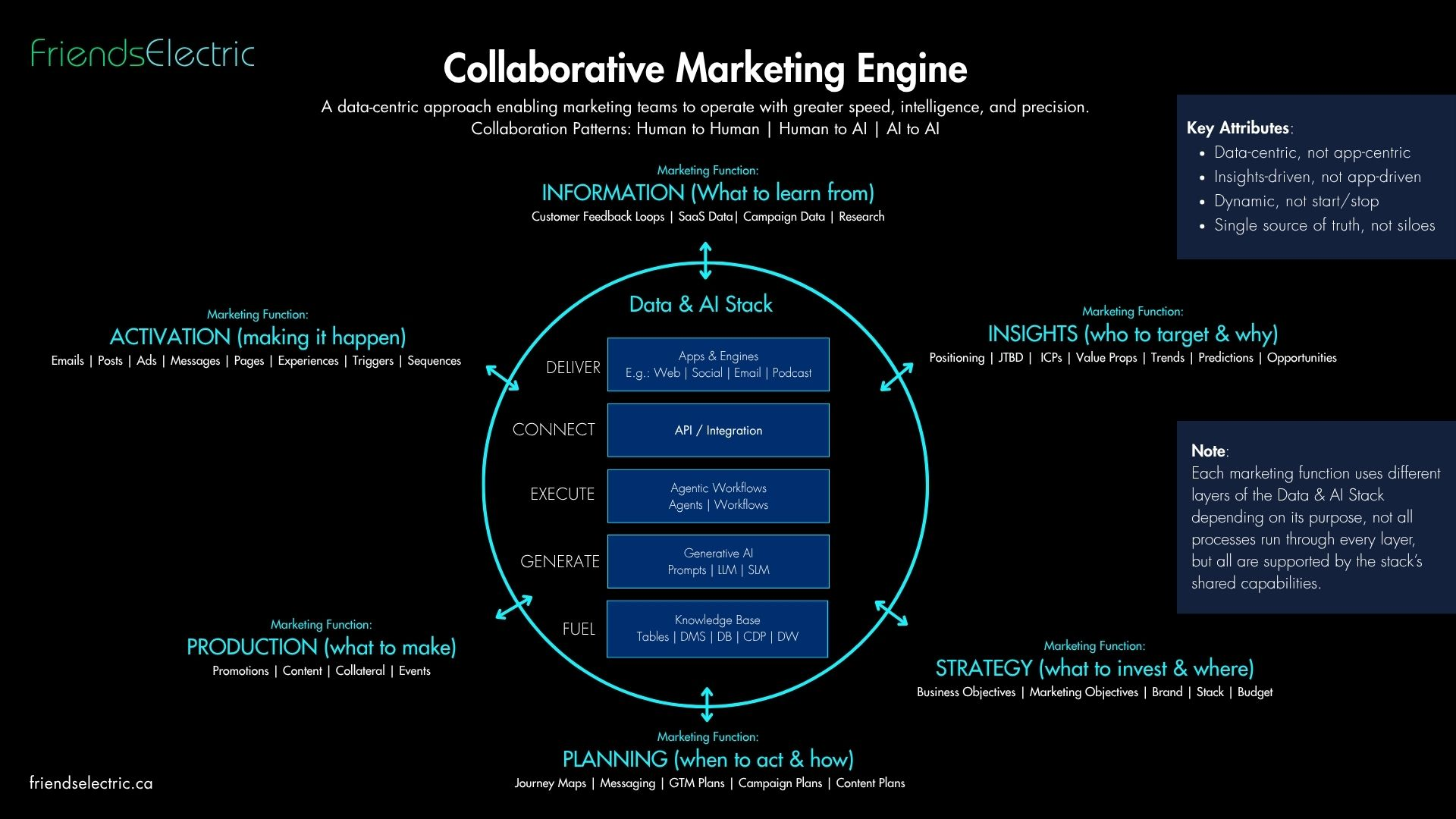Why I'm a data-centric marketer (and why it matters more than ever in the age of AI)
In a time when Generative AI can pump out blog posts, emails, and landing pages in seconds, it's tempting to believe we’ve entered an era of marketing abundance. But anyone who's worked with these tools knows the truth: without structured, high quality inputs, the outputs are forgettable at best and risky at worst.
That is why I take a data-centric approach to marketing. Not just in the sense of tracking KPIs or building dashboards, but in a much deeper way. For me, data-centric marketing means building structured sources of truth that support the entire marketing engine from analysis to activation.
When I approach a new marketing challenge, whether it’s a product launch or campaign plan, I don’t start by writing a document. I start by modeling it in data. That might sound surprising or even disappointing to some, especially since many of us have spent our careers honing our writing skills. But these days, I think of myself more as a seasoned editor than a cub reporter, and as you might have guessed, it is often AI systems that now handle many of the first drafts.
“Without data, you're just another person with an opinion.”W. Edwards Deming
Spreadsheets were my entry point
While I’ve definitely ramped up my focus on data in recent years, I think I have always been naturally drawn to a data-centric approach.
Back in 2015, I led a multi-channel launch for a North American B2C marketplace across 25 major cities. We couldn’t afford all the martech we needed, and a data warehouse to integrate apps and data had a $2 million dollar price tag and a 2-year timeline, so I decided to run the entire campaign using a multi-tabbed spreadsheet.
At the time, it felt like a wild hack. In hindsight, it was my first data-centric initiative.
That mindset stuck.
Poor data quality costs organizations an average of $12.9M USD per year.Source: Gartner, 2018
Simplifying the martech stack
The ever-increasing use of disconnected, costly apps that fragment data and intelligence was never going to be a happy ending for marketing teams.
The reality is that systems tend to fail once they cross a certain complexity threshold, a tipping point described in Gall’s Law which warns that complex systems must evolve from simple, functional ones. New technologies like Customer Data Platforms (CDPs) can help, but I see them as band-aid solutions that don’t address the root cause of complexity, which is data fragmentation caused by the proliferation of marketing apps.
The good news is that there’s a critical shift towards simplicity I see happening with the increased adoption of AI tools and systems. Instead of managing 100 versions of the same information across multiple apps, teams are increasingly using knowledge bases (aka single sources of truth) that can power unlimited marketing outcomes by plugging into Generative AI and Agentic AI systems.
For example, if you update a value proposition in a knowledge base, it can be instantly cascaded across all of your slide decks, web pages, and ad copy.
That use case represents more than just workflow optimization. It's actually a fundamental shift guided by a series of key principles, many of which are outlined in the Data Collaboration Framework, a national Canadian standard which I was privileged to co-author.
This is not just about working faster. It is about working smarter. When data is clear, shared, and accessible, human teams and AI systems can use it to turn insights into action with unprecedented efficiency.
That’s the real promise of AI in marketing.
45% of leaders cite data accuracy or bias as a top AI adoption barrier, highlighting the need for structured data and processes.Source: IBM blog
Use cases in data-centric marketing
- Growth strategies
When evaluating growth strategies for clients, I survey stakeholders and collect the top 10 ideas in a structured data format (spreadsheet). Each idea is then scored (using a survey front-end) against multiple weighted criteria by client stakeholders, myself, and multiple AI systems. The result? Transparent decisions evaluated by a diverse set of intelligences within a dataset that can be used again and again to execute growth tests and pilot projects.
Fun Fact: The approach of scoring strategic alternatives is one of the many best practices I learned by completing CMA's Certified Marketer program.
- Product Playbooks
I build product playbooks in spreadsheets or simple database apps like Airtable by creating individual tabs or sheets for core elements such as competitive intelligence, SWOTs, positioning, personas, value props, GTM plans, messaging frameworks, and more. These become living sources of truth that combine with Generative AI systems to power a huge range of marketing deliverables, including blog posts, social posts, video scripts, battle cards, and lead magnets. - Campaign Plans
The same data-centric approach applies to planning complex marketing activities like integrated campaigns. I organize the key elements such as target audience, value props, key messaging, creative assets, call to action, channels, and dates in a reusable format that makes Generative AI a more reliable and effective reliable partner, working from clear, concise data instead of having to infer things from long-form documents or briefs.
48% of B2B marketers say content repurposing is their biggest challenge in scaling content production. Source: Content Marketing Institute, 2023
A new way to express creativity and intelligence
Most marketers don’t think of tabs and tables as collaborative tools. More often than not, marketing spreadsheets sit on someone’s laptop, siloed from the rest of the team.
But structured data isn’t just a technical or administrative task, it’s a creative practice. Like writing a white paper or designing a landing page, it’s an intentional act of expression, and it becomes even more powerful when it creates a shared language between humans and AI systems.
There’s an art to it.
Sometimes I lay out columns in a new table to tell a story, left to right, like a narrative arc. In this way, almost anything, including a campaign, budget, brand, customer persona, or content plan, can be broken down into distinct, non-overlapping data points.
Marketers are storytellers by nature. Structured data formats aren’t a limitation, they're just another way to craft messages and communicate more efficiently, and at scale.
Your unique voice should always shape the final version.
source=chatgpt.com
I am not a blind advocate for AI in marketing. I use it incrementally, guided by a clear adoption framework that considers team skills, change management, ethics, and data readiness.
I am also fully aware of how automation is reshaping marketing careers, including my own. In fact, it is the main reason why I recently updated the mission of Ask AI, a nonprofit I founded in 2017, to focus directly on AI and the future of work.
But here’s the thing: marketing responsibilities continue to expand, often outpacing the capacity of available resources.
For example, managing retail media network campaigns (RMN), producing branded podcasts, and adapting SEO strategies for Generative Engine Optimization (GEO) are all tasks that barely existed a few years ago and are now quickly becoming essential parts of modern marketing. This makes the case for data and AI support even more compelling.
So whatever your view on automation, the ability to work with AI to scale your insights and marketing expertise is not just an opportunity, it’s probably a necessity.
74% of CMA members use generative AI tools weekly, significantly higher than the 62% average for Canadian knowledge workers. Source: CMA: Evolution of Marketing Roles in the AI Era
Agents, marketing, and data-centricity
Agentic AI is all the buzz right now, and as marketers begin to explore it, they’ll quickly discover that agentic automations are powered by something that’s familiar but not often used in marketing: Standard Operating Procedures (SOPs).
These are essentially sets of instructions that are sequenced and supported to conditional logic, which I generally shortcut to “if this, then that”.
The good news is that SOPs are easily captured and structured in a simple data management environment like a spreadsheet. In fact, I recently documented an SOP to capture the end-to-end process of conceiving, planning, recording, publishing, and tracking podcast episodes.
This kind of structure not only clarifies and streamlines your marketing process but also lays the foundation for agentic tools and automation. Even if you are not ready to launch automation yet, capturing SOPs in structured data creates immediate value by enabling Generative AI bots to guide others through complex marketing tasks step by step.
In my opinion, marketers who already think and work in terms of structured data will have a huge advantage in a shifting job market. If you’ve built a reusable product playbook, campaign tracker, or strategy model, you’re already halfway to building an agent.
AI-enabled organizations see 28% productivity gains.Source: CMA: Evolution of Marketing Roles in the AI Era
Practical steps toward data-centric marketing
If you're curious where to begin, here are a few practical steps to help get you started:
- Get to know basic data modeling: Not as a technical discipline, but as a way to represent real-world marketing concepts (e.g. positioning, personas, segments, value props, campaigns, and plans) in structured columns. Gaining this skill is empowering.
- Explore the roots of data-centric thinking: Check out the work of Dave McComb, a leading voice in this space. While he may not officially carry the title, he's widely seen as a foundational thinker in the data-centric movement. His work lays out the philosophical and technical foundations of how structured data helps systems (and people) work better together.
- Test AI tools that leverage data: OpenAI’s ChatGPT ‘Projects’ feature and Google’s NotebookLM product enable marketers to upload data to support strategic initiatives such as yearly marketing plans, content plans, and product launches. Similarly, Google ‘Gems’ and ChatGPT ‘Custom GPTs’ can use sources like product playbooks to help scale specific tasks such as drafting ad copy, social posts, and scripts (Pro tip: delete the hyphens).
Final thoughts
This blog post represents where I am right now as a marketer but the truth is that I’ve always been drawn to the simplicity and power of the data-centric approach. With today’s AI tools and systems, that mindset only makes more sense to me.
But things are evolving fast and it’s entirely possible that soon I’ll pivot once again, maybe even back to longform words that I dictate into my AI glasses. Who knows.
But in my experience, if you want to do AI marketing right at this particular time you have to get your data right. That starts with shifting your mindset from content first to context first.
And to me, that means becoming a data-centric marketer.
About the author
Chris McLellan is a certified Chartered Marketer and principal at Friends Electric, a marketing consultancy focused on building AI-powered growth programs rooted in data-centric practices. He also serves on the AI Committee of the Canadian Marketing Association, chairs the Technical Committee for the Data Collaboration Framework at the Digital Governance Council, and has been the Founder and Volunteer Producer of the Ask AI podcast since 2017.





































